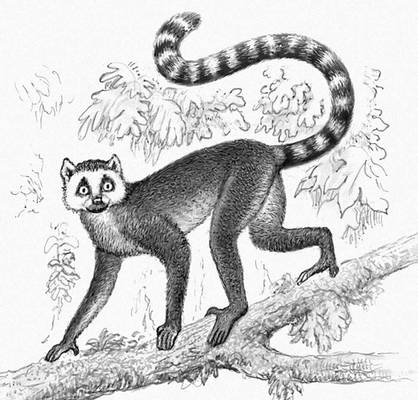Перевод и анализ слов искусственным интеллектом ChatGPT
На этой странице Вы можете получить подробный анализ слова или словосочетания, произведенный с помощью лучшей на сегодняшний день технологии искусственного интеллекта:
- как употребляется слово
- частота употребления
- используется оно чаще в устной или письменной речи
- варианты перевода слова
- примеры употребления (несколько фраз с переводом)
- этимология
lesser mouse lemur - перевод на русский
общая лексика
мышиный лемур (Microcebus murinus)
Смотрите также
Определение

Википедия
The gray mouse lemur (Microcebus murinus), grey mouse lemur or lesser mouse lemur, is a small lemur, a type of strepsirrhine primate, found only on the island of Madagascar. Weighing 58 to 67 grams (2.0 to 2.4 oz), it is the largest of the mouse lemurs (genus Microcebus), a group that includes the smallest primates in the world. The species is named for its mouse-like size and coloration and is known locally (in Malagasy) as tsidy, koitsiky, titilivaha, pondiky, and vakiandry. The gray mouse lemur and all other mouse lemurs are considered cryptic species, as they are nearly indistinguishable from each other by appearance. For this reason, the gray mouse lemur was considered the only mouse lemur species for decades until more recent studies began to distinguish between the species.
Like all mouse lemurs, this species is nocturnal and arboreal. It is very active, and though it forages alone, groups of males and females form sleeping groups and share tree holes during the day. It exhibits a form of dormancy called torpor during the cool, dry winter months, and in some cases undergoes seasonal torpor (or hibernation), which is unusual for primates. The gray mouse lemur can be found in several types of forest throughout western and southern Madagascar. Its diet consists primarily of fruit, insects, flowers, and nectar. In the wild, its natural predators include owls, snakes, and endemic mammalian predators. Predation pressure is higher for this species than among any other primate species, with one out of four individuals taken by a predator each year. This is counterbalanced by its high reproductive rate. Breeding is seasonal, and distinct vocalizations are used to prevent hybridization with species that overlap its range. Gestation lasts approximately 60 days, and typically two young are born. The offspring are usually independent in two months, and can reproduce after one year. The gray mouse lemur has a reproductive lifespan of five years, although captive individuals have been reported to live up to 15 years.
Although threatened by deforestation, habitat degradation, and live capture for the pet trade, it is considered one of Madagascar's most abundant small native mammals. It can tolerate moderate food shortages by experiencing daily torpor to conserve energy, but extended food shortages due to climate change may pose a significant risk to the species.

![Grey mouse lemur at night in the [[Anjajavy Forest]] Grey mouse lemur at night in the [[Anjajavy Forest]]](https://commons.wikimedia.org/wiki/Special:FilePath/Gray mouse lemur microcebus murinus.jpg?width=200)
![The ''[[tapetum lucidum]]'', responsible for eyeshine, reflects light to enhance night vision. The ''[[tapetum lucidum]]'', responsible for eyeshine, reflects light to enhance night vision.](https://commons.wikimedia.org/wiki/Special:FilePath/Microcebus-murinus.jpg?width=200)


